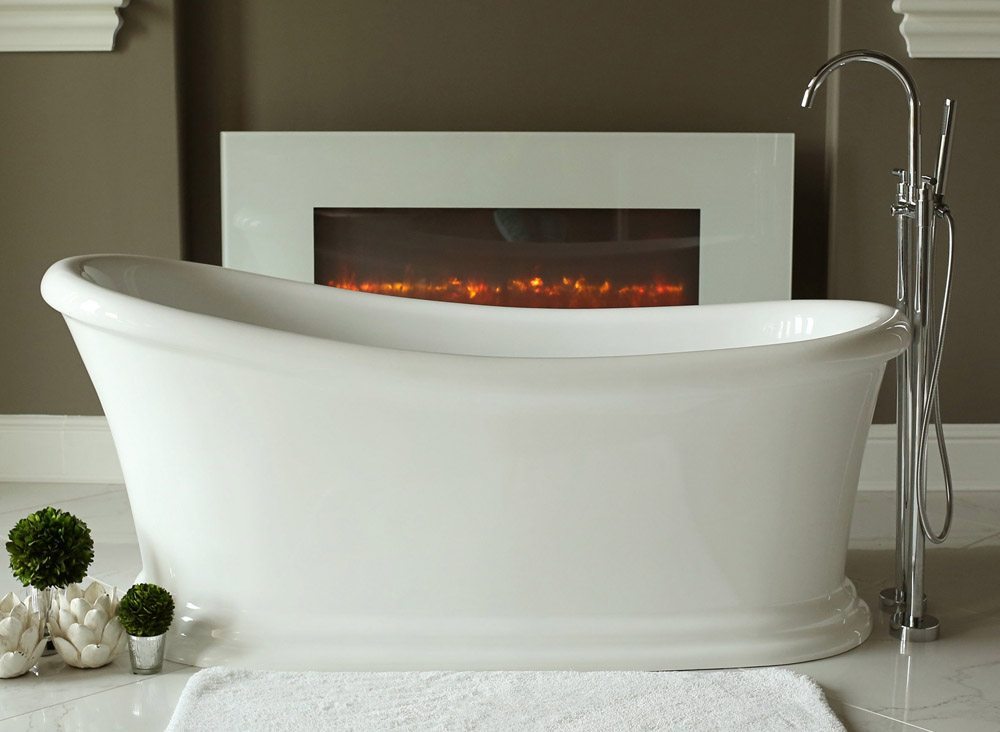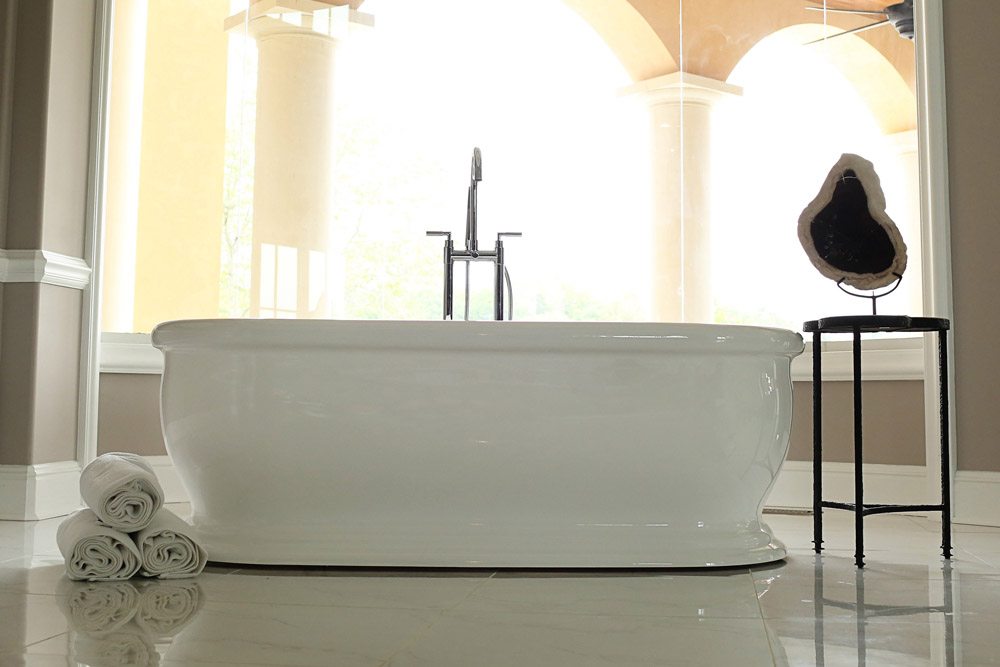
Asking the question built-in vs freestanding baths? Picking out the perfect tub for you isn’t as simple as choosing a model in your favorite color. Among other things, you also need to consider whether you want to go with an elegant freestanding bath or a more practical built-in bath.
Key Questions to Ask Before Purchasing a Tub
To help you make your decision, you should ask yourself these six key questions when comparing built-in vs freestanding baths:
- What kind of aesthetic am I going for?
- How frequently do I plan on bathing?
- How large is my space?
- What type of bath will my plumbing accommodate?
- How much am I willing to spend?
- How much do additional conveniences like heat retention and ease of cleaning matter to me?
Ready to find out whether a freestanding or built-in bath is right for you? Let’s get started.
What Is a Freestanding Bath?
Think of a glamorous bathroom, and you’ll likely picture some sort of freestanding bath. These types of baths are surrounded by open-air on all four sides and are connected to your house’s plumbing through the floor rather than the wall.
Freestanding baths have been used for thousands of years in the form of wooden, clay or metal tubs, filled with either hand-drawn water or, with the advent of modern plumbing, with water from a tap. In short, you can’t get much more traditional than a freestanding bath.
When freestanding baths have feet, they’re generally known as clawfoot tubs:

Clawfoot tubs first gained popularity in Victorian times, when they were viewed as a luxury item reserved for the upper class. Although improved manufacturing processes have led to lower prices, they’re still seen as a symbol of elegance and sophistication.
Other types of freestanding baths have a flat bottom, like this one:

What Is a Built-In Bath?
While freestanding tubs have existed for millennia, built-in baths have only been common since the mid-20th century. These types of baths are enclosed on two to three sides, with the fourth side facing the room in which it’s installed.
Built-in baths are typically made from acrylic and feature a shower head attachment. This makes it possible to use them for both baths and showers with the addition of a shower curtain or sliding door.
However, they can also be installed independently of a separate shower stall:

Now that you know the difference between freestanding baths and built-in baths, as well as the various types of each that are available, let’s explore how you can determine which is best for you.
1. What Kind of Aesthetic am I Going For?
You can easily narrow down your choices of built-in vs freestanding baths by identifying the overall aesthetic you’re after.
Freestanding tubs are excellent for creating a look that’s:
- Elegant
- Rustic
- Traditional
- Sophisticated
- Old-world
- Cozy
On the other hand, built-in tubs are perfect for creating a look that’s:
- Modern
- Minimalist
- Sleek
- Simple
Of course, freestanding baths can be made to look modern and streamlined, and built-in baths can be made to look elegant and grand. However, each type of bath lends itself particularly well to specific aesthetics.
2. How Frequently Do I Plan on Bathing?
As mentioned earlier, built-in baths typically feature a wall- or ceiling-mounted showerhead. And, since they only have one or two sides exposed to the room, they can easily be outfitted with a shower curtain or sliding doors. This makes them ideal for comfortable and convenient showering.
By contrast, freestanding baths can make showering more challenging. Since all four sides are exposed, you’ll need a 360° curtain, which could feel like it’s getting in the way while you’re showering.
Plus, many freestanding baths have curved bottoms that are designed for laying down rather than standing. This could mean a higher risk of slipping or losing your balance. If you shower more often than you bathe, these issues can quickly become tiresome.
If you plan on using a separate shower stall, none of those points are relevant. However, if you don’t want to spend the money on an additional showering area, you should consider whether you take baths frequently enough to justify a freestanding tub.
3. How Large Is My Space?
While freestanding baths can look fantastic in just about any space, they can easily dominate smaller bathrooms and create a more cramped feel.
If you plan on using your freestanding bath as a shower, you’ll likely be able to get by with some strategic placement. For example, you can maximize space by placing your freestanding bath as close to the wall as possible, or by placing it in a corner rather than in a more central location.
However, if you want to install a freestanding bath in addition to a shower stall, you’ll need adequate space for both, while still leaving enough room for your sink, toilet and storage.
4. What Type of Bath Will My Plumbing Accommodate?
If you have visions of a freestanding bath serving as the centerpiece of your bathroom, take a moment to consider whether your plumbing will accommodate that layout.
In most bathrooms, built-in plumbing hookups are located in the walls, not underneath the floor. Unless you already have a hookup located underneath the floor, installing a freestanding tub in the middle of your bathroom will involve additional plumbing work, as well as ripping up your floor.
So, if your bathroom floor is decorated with beautiful tile work you don’t want to replace, or if your budget simply won’t allow for the extra expense, you’ll either have to place your freestanding bath in a different location or go with a built-in bath instead.
5. How Much Am I Willing to Spend?
On the surface, it may seem like all baths perform a similar function, and thus will be available for similar prices.
However, don’t discount the fact that built-in baths are usually made from more inexpensive materials like acrylic, and also require only one or two exterior surfaces.
Read about 9 common bathtub materials and their pros and cons.
Compare that to traditional freestanding baths, which are typically crafted from heavier, more expensive materials like cast iron, and require four exterior surfaces.
These differences result in a price variation that can be significant.
6. How Much Do Additional Conveniences Matter to Me?
There are a few other conveniences that you should take into consideration.
For instance, freestanding baths tend to:
- Lose heat quicker than built-in baths.
- Be more difficult to clean around and under.
- Be heavier than built-in baths, which may require additional reinforcement of your floor.
- Not include a built-in shelf for storing oils, salts and other bath products.
On the other hand, built-in baths tend to:
- Retain heat well, thanks to the insulation that’s already in your walls.
- Be easier to clean around, with no space underneath and fewer exposed sides.
- Be much lighter than freestanding baths.
- Include a built-in shelf surrounding the bath for storing bath products.
Whether or not each of these conveniences matters enough to you to sway your decision is up to your personal preferences.
Which Type of Bath is Right for Me?
Now that we’ve gone over the details of both freestanding and built-in baths, let’s sum things up with an easy checklist.

A freestanding bath could be the best choice for you if:
- You’re seeking an elegant, rustic or traditional look.
- You plan on taking baths often.
- You have ample space in your bathroom.
- You’re willing to pay for additional plumbing and floor work if required.
- You’re willing to spend more than you would for a built-in bath.
- You don’t view additional conveniences like easy cleaning and heat retention as an issue.
A built-in bath may be the best choice for you if:
- You’re looking for a streamlined or modern look.
- You don’t plan on taking frequent baths.
- You have limited space in your bathroom.
- You don’t want to pay for additional plumbing and floor work.
- You’re looking to spend less than you would for a freestanding bath.
- You value additional conveniences like easy cleaning and heat retention.
IIn the end, when comparing built-in vs freestanding baths – you can use both to create a stunning aesthetic and provide you with a luxurious bathing experience.
However, considering the factors listed here can make it much easier to choose a bath that will perfectly meet your needs for years to come.





